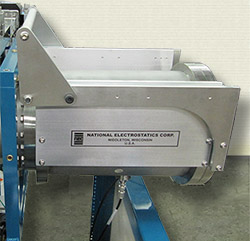The modern particle accelerator is one of the most versatile instruments designed by physicists in the 20th century. Today, accelerators are widely used in nearly every field of physics from elementary particles to nuclear damage studies. They are also essential instruments in many other areas of research, including chemical structure studies, pharmaceutical development, and astrophysics. Systems built by NEC have been involved in many scientific breakthroughs around the world since NEC was founded in 1965.
NEC has provided over 240 Pelletron and High Voltage systems around the world to perform a number of scientific techniques. New applications are being discovered every year for existing techniques. The three most common techniques for which NEC’s systems are used are Accelerator Mass Spectrometry (AMS), Ion Beam Analysis (IBA), and Ion Implantation.
Accelerator mass spectrometers detect atoms of specific elements according to their atomic weights. The process of AMS begins by processing sample material, often as little as 50 micrograms, and placing it into the ion source. The sample material is converted to a negative ion and accelerated to extraordinarily high kinetic energies. The ion beam passes through a gas or foil stripper to remove electrons, and the resulting ion beam passes through mass and electrostatic filters to remove isobars. AMS can detect 14C/12C ratios below 3 ⋅ 10-16.
Carbon AMS is by far the most common, although there is growing worldwide interest in studying beryllium, aluminum, calcium, iodine, chlorine, and the actinides.
NEC manufactures AMS systems in different energies, depending on the isotopes to be studied:
|
|
|
See our AMS systems for more information. See our Positive Ion Mass Spectrometry (PIMS) systems for information on an exciting new AMS alternative technique developed by NEC in partnership with SUERC and Pantechnik.
Ion Beam Analysis is a generic term used to describe a variety of accelerator techniques that mostly focus on interactions between MeV light elements (H, He) and materials. All IBA techniques are extremely sensitive and allow the detection of elements in the first nanometers (or deeper) of a material. Typical beam energies range from 2 MeV to 6 MeV and higher.
Common techniques include:
NEC manufactures IBA systems in different energies, depending on the isotopes to be studied:
|
|
|
See our IBA systems for more information.

Ion implantation is a materials modification process by which ions are accelerated, typically in a single ended accelerator, and inserted into a solid. This process is used to change the physical, chemical, or electrical properties of the solid. NEC has manufactured Open Air ion implantation systems for beam energies in the 150 to 500 keV range. Single ended or tandem accelerators can be used for beam energies of over 400 keV. NEC offers both high temperature (800º C) and low temperature implant chambers.
|
|
|
NEC can also build:
Please contact NEC if you have questions or specifications regarding existing and/or potential applications for our systems.